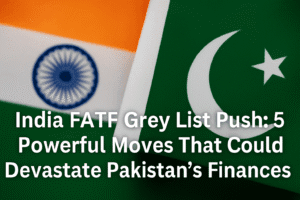India FATF Grey List Push: 5 Powerful Moves That Could Devastate Pakistan’s Finances
India is strategically leveraging diplomacy to intensify financial pressure on Pakistan following recent military tensions. Foreign Secretary Vikram Misri’s visit to Washington secured crucial U.S. coordination for India’s push to reinstate Pakistan on the FATF “grey list” at June’s plenary. This move aims to trigger real economic consequences – heightened banking scrutiny, reduced investment, and damaged credibility – directly targeting Pakistan’s alleged terror financing infrastructure.
Beyond FATF, India is systematically opposing international financial aid to Pakistan, notably World Bank funding. The effort forms a core pillar of India’s post-Operation Sindoor strategy, shifting from kinetic action to sustained institutional pressure. While broader talks covered trade, tech, and defense cooperation, the FATF alignment highlights the enduring centrality of counter-terrorism in U.S.-India ties. India seeks to constrict financial channels sustaining groups like LeT and JeM, viewing FATF as a critical accountability tool. The June session becomes a key test of India’s diplomatic resolve to isolate Pakistan economically over cross-border terrorism.

India FATF Grey List Push: 5 Powerful Moves That Could Devastate Pakistan’s Finances
The recent visit of India’s Foreign Secretary Vikram Misri to Washington wasn’t just routine diplomacy. It was a calculated move in a high-stakes geopolitical chess game, with Pakistan firmly in the crosshairs. The core objective? Securing U.S. backing for India’s push to have Pakistan reinstated on the FATF “grey list” during the upcoming June plenary. This effort is far more than procedural; it’s a critical component of India’s multi-pronged strategy following the tense military confrontation with Pakistan earlier this year.
The Washington Mission: More Than Just FATF
While Misri’s discussions covered the broad pillars of the India-US relationship – “technology, trade, and talent” – the meeting with Deputy Treasury Secretary Michael Faulkender held particular weight. Explicitly mentioning “coordination in the upcoming FATF processes” signals India’s intent to leverage the relationship to achieve a specific, impactful outcome. The timing is crucial: coming weeks after Operation Sindoor, India’s counter-terror operation inside Pakistan, this diplomatic offensive underscores a shift towards sustained financial and institutional pressure.
Why Grey-Listing Matters (Beyond the Headlines)
The FATF grey list isn’t merely a symbolic rebuke. Inclusion signifies a country is under increased monitoring for deficiencies in combating money laundering and terrorist financing. The practical consequences are severe:
- Economic Isolation: Grey-listed countries face heightened scrutiny from international banks and financial institutions. Transactions become slower, more expensive, and riskier, deterring foreign investment and complicating trade.
- Reputational Damage: It brands Pakistan internationally as a high-risk jurisdiction, undermining its economic credibility.
- Leverage: It provides India and other nations with tangible leverage to demand concrete, verifiable action against UN-designated terror groups like Lashkar-e-Taiba (LeT) and Jaish-e-Mohammed (JeM), which India holds directly responsible for cross-border terrorism.
India’s strategy, as hinted by the report of opposing further World Bank funding to Pakistan, is clear: systematically constrict the financial oxygen available to Pakistan, particularly pressuring its security establishment, which India alleges maintains links to these terror groups.
The Trump Factor and the Broader Canvas
President Trump’s repeated claims about personally halting the “nuclear disaster” between India and Pakistan add a complex layer. While highlighting the perceived fragility of the situation and US influence, it also underscores the continued centrality of the Pakistan issue in US-India dynamics. Misri’s visit served to manage this relationship beyond the immediate crisis:
- Trade & Tech: Progress on the Bilateral Trade Agreement and Critical Technologies cooperation signals a desire to deepen ties beyond security.
- Defense Deepening: Discussions with Pentagon officials on co-production, joint exercises, and interoperability point to a maturing defense partnership, crucial for long-term strategic alignment.
The Human Insight: A Strategy of Sustained Pressure
The real story here isn’t just a diplomatic meeting; it’s India’s evolving playbook. Operation Sindoor demonstrated military resolve. Now, Misri’s mission represents a pivot towards long-term, institutional pressure:
- From Kinetic to Financial: Moving beyond episodic military responses to a sustained campaign using international financial mechanisms.
- Building Coalitions: Actively seeking key partners, especially the US, to amplify pressure and isolate Pakistan within bodies like FATF and the World Bank.
- Targeting the Lifeline: Focusing relentlessly on the alleged nexus between Pakistan’s security apparatus and terror financing, aiming to disrupt the financial flows sustaining anti-India militancy.
The Road Ahead
The June FATF plenary will be a critical test of India’s diplomatic heft and its ability to translate recent geopolitical maneuvering into concrete action. Success would mark a significant victory in its campaign to hold Pakistan accountable for cross-border terrorism through non-military means. However, challenges remain: navigating complex US interests in the region (including Afghanistan), ensuring sustained international consensus, and ultimately, forcing verifiable structural change within Pakistan. Foreign Secretary Misri’s Washington visit was a deliberate step in this intricate, high-stakes strategy, demonstrating that India’s response to terrorism now extends far beyond its borders and into the complex arena of global finance and diplomacy.
You must be logged in to post a comment.